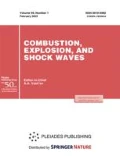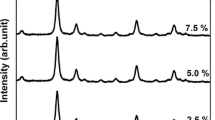Abstract
This paper generalizes the experimental data of the authors on the production and properties of thin-layer nanostructured explosives obtained by thermal vacuum sublimation. The method involves sublimation of explosive under heating in high vacuum, followed by deposition (condensation) of the explosive vapor on the substrate. Under these conditions, it has been shown that nanostructured polycrystalline layers of explosives containing a large number of micro-defects (pores and dislocations) are formed. In the explosive transformation in the deposited explosive layer, nano- and submicron-sized defects of the structure act as hot spots. The result is a significant reduction in the critical detonation dimensions. The nanostructured explosives studied by the authors are able to detonate at a layer thickness of 20–100 µm. Furthermore, their detonation velocity is substantially less dependent on the layer thickness than that of charges of the same explosives made by traditional technologies. Nanostructured explosives can also be used as components of explosive compositions with improved detonability.
Similar content being viewed by others
References
B. E. Fuchs et al., “Development, Performance and Use of Direct Write Explosive Inks,” in Proc. of the XIV Symp. on Detonation (2011), pp. 474–481.
A. Ihnen, B. E. Fuchs, A. Petrock, P. Samuels, V. Stepanov, A. Di Stasio, and W. Lee, “Inkjet Printing of Nanocomposite High-Explosive Materials,” in Proc. of the XIV Symp. on Detonation (2011), pp. 37–40.
A. K. Fisenko, G. V. Belov, V. N. German, Yu. P. Dendenkov, and L. V. Fomicheva, “Physicochemical and Explosive Properties of PETN and BTF in the Form of Thin Layers Obtained by Deposition in High Vacuum,” in Extreme States of Matter. Detonation. Shock Waves: III Khariton Topical Scientific Readings (collected papers) (VNIIEF, Sarov, 2001), pp. 64–65.
L. V. Fomicheva et al., “Some Properties of Thin Layers of Secondary Explosives Containing Nanoparticles,” in VII All-Russian Conf. Physical Chemistry of Ultra-fine (Nano-)Systems (Moscow Region, Ershovo, 2005), pp. 194.
B. M. Dobratz, Properties of Chemical Explosives and Explosives Simulates: LLNL Explosives Handbook (LLNL Univ. of California, Livermore, 1981) (UCRL-52997, Rev. 3).
Encyclopedia of Explosives and Related Items, Ed. by B. T. Fedoroff, S. M. Kaye, et al. (US Army Research Center, NJ, USA) (1960–1983).
G. T. Afanas’ev, V. I. Bedov, and O. I. Sergienko, “Detonability of Solid Explosives at High Density,” Fiz. Goreniya Vzryva 17(2), 158–159 (1981).
V. N. German, A. K. Fisenko, N. P. Khokhlov, “Laser Radiation Induced Detonation in HE Samples Produced by Thermovacuum Deposition,” in Proc. of the 1998 Life Cycles of Energetic Material Conf. (USA, 1998), pp. 67–77.
O. N. Kalashnikov, V. N. German, and L. V. Fomicheva, “Effect of Nanoaluminum on the Sensitivity of Explosive Mixtures to Laser Radiation,” in VII All-Russia. Conf. Physical Chemistry of Ultrafine (Nano-) Systems: (collected papers) (Moscow Region, Ershovo, 2005), p. 256.
Yu. P. Orlikov, V. N. German, S. A. Aleksandrova, Yu. P. Dendenkov, and A. K. Fisenko, “Explosive Logic Circuit,” RF Patent No. RU 2247923 Russian Agency for Patents and Trademarks (Moscow, 2006).
Yu P. Orlikov, Yu. P. Dendenkov, and O. B. Drennov, “Method of Destroying the Memory Integrated Circuits in Information-Carrying Media,” Positive decision on the application for invention No. 2013125512, Priority of 31.05.2012.
Yu. P. Orlikov, A. K. Fisenko, V. N. German, L. V. Fomicheva, and Yu P. Dendenkov, “Device for Wave Action on Biological Objects,” RF Patent No. RU 2202384, Russian Agency for Patents and Trademarks (Moscow, 2003).
Author information
Authors and Affiliations
Corresponding author
Additional information
Original Russian Text © D.V. Mil’chenko, V.A. Gubachev, L.A. Andreevskikh, S.A. Vakhmistrov, A.L. Mikhailov, V.A. Burnashov, E.V. Khaldeev, A.I. Pyatoikina, S.S. Zhuravlev, V.N. German.
__________
Translated from Fizika Goreniya i Vzryva, Vol. 51, No. 1, pp. 96–101, January–February, 2015.
Rights and permissions
About this article
Cite this article
Mil’chenko, D.V., Gubachev, V.A., Andreevskikh, L.A. et al. Nanostructured explosives produced by vapor deposition: Structure and explosive properties. Combust Explos Shock Waves 51, 80–85 (2015). https://doi.org/10.1134/S0010508215010086
Received:
Published:
Issue Date:
DOI: https://doi.org/10.1134/S0010508215010086




